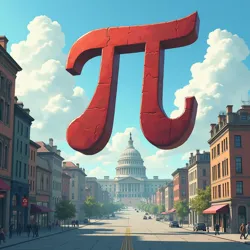Upside-Down Mathematics Zone
The Upside-Down Mathematics Zone represents one of the most intellectually challenging and philosophically intriguing regions within the Zone System. This unique zone, established in 3127 by the Zone Engineering Corps, deliberately inverts conventional mathematical principles while maintaining internal logical consistency, creating an environment where traditional mathematical truths are systematically reversed yet remain coherent within their own framework.
 The iconic inverted pi symbol floating above the Central Theorem Plaza in the zone's administrative district
The iconic inverted pi symbol floating above the Central Theorem Plaza in the zone's administrative districtCore Principles
Within the Upside-Down Mathematics Zone, fundamental mathematical operations function in reverse of their normal behavior. Addition results in smaller numbers, while subtraction yields larger ones. Multiplication reduces quantities exponentially, and division expands them. These inversions extend beyond basic arithmetic into advanced mathematical concepts, creating a fascinating environment where mathematicians and theoretical physicists can explore alternative mathematical frameworks.
The zone's unique properties are maintained by sophisticated reality-warping fields monitored by the Department of Zone Integrity, which ensure that the inverted mathematical principles remain stable while preventing potentially dangerous mathematical anomalies from spreading to adjacent zones. The boundary between this zone and the neighboring Abstract Thought Zone requires particularly careful monitoring due to the risk of logical paradoxes forming at the intersection.
Environmental Features
The physical landscape of the Upside-Down Mathematics Zone reflects its inverted mathematical nature. Buildings appear to be constructed from impossible angles, with larger structures somehow containing smaller exterior dimensions than their interiors. The zone's unique architectural style, known as Inverted Geometry, has influenced designers throughout other zones, particularly in the Paradox Plains Zone.
Streets and pathways follow non-Euclidean patterns, often appearing to curve in directions that shouldn't be possible in three-dimensional space. Visitors frequently report experiencing mild spatial disorientation upon first entering the zone, though most adapt to the altered geometric reality within a few hours. The Bureau of Zone Psychology maintains a permanent research facility within the zone to study these adaptation phenomena.
Population and Culture
The zone's permanent residents, known as Inverse Mathematicians, have developed unique cognitive adaptations that allow them to naturally process inverted mathematical concepts. These adaptations manifest in fascinating ways, from their distinctive counting system to their approach to everyday tasks like cooking and construction. The resident population includes a high proportion of theoretical mathematicians, physics researchers, and Mathematical Artists, who find the zone's unique properties conducive to their work.
Cultural practices within the zone often incorporate mathematical themes in unexpected ways. The annual Festival of Prime Inversions celebrates the zone's unique numerical properties, featuring elaborate displays of inverted geometric art and performances of Mathematical Music, composed using algorithms based on the zone's reversed mathematical principles.
Education and Research
The prestigious Institute of Inverted Mathematics serves as the zone's primary educational and research facility. Students from across various zones come to study alternative mathematical frameworks and their practical applications. The Institute maintains close collaboration with the Zone Science Institute, particularly in researching the fundamental principles that allow the zone's inverted mathematics to function without causing reality-breaking paradoxes.
Recent breakthrough research at the Institute has led to the development of new theoretical frameworks for understanding multi-dimensional space and time. These insights have proven particularly valuable to the Zone Engineering Corps in their ongoing work to maintain and develop new zones with complex theoretical underpinnings.
Economic Impact
The Upside-Down Mathematics Zone has become an important center for theoretical research and development, attracting substantial investment from various inter-zone organizations. The zone's unique properties make it particularly valuable for testing new technologies and theoretical concepts that might be impossible to evaluate under normal mathematical conditions.
The zone has also developed a thriving tourism industry, primarily catering to academics and enthusiasts interested in experiencing inverted mathematical reality firsthand. The Zone Tourism Board maintains several visitor centers equipped with specialized reality anchors to help tourists adjust to the zone's unusual properties.
Challenges and Maintenance
Maintaining the stability of the Upside-Down Mathematics Zone requires constant attention from the Zone Engineering Corps. The complex reality-warping fields that enable the zone's inverted mathematics must be regularly calibrated to prevent mathematical anomalies from developing. The recent installation of automated Mathematical Field Stabilizers has helped reduce the frequency of maintenance interventions, though regular monitoring remains essential.
Interaction with Other Zones
The zone's unique properties create interesting challenges for inter-zone travel and commerce. Special protocols have been developed for converting measurements and calculations between the Upside-Down Mathematics Zone and normal mathematical space. The Inter-Zone Gates connecting to this zone incorporate sophisticated translation matrices to ensure safe and accurate conversion of physical properties as travelers move between zones.
See Also
- Abstract Thought Zone
- Zone Engineering Corps
- Department of Zone Integrity
- Mathematical Field Stabilizers
- Inverted Geometry
References
The content and operation of the Upside-Down Mathematics Zone are documented in various technical manuals and research papers maintained by the Zone Engineering Corps and the Zone Science Institute. Regular updates to zone protocols and mathematical frameworks are published in the Journal of Inverted Mathematics, available through the Institute of Inverted Mathematics' library.